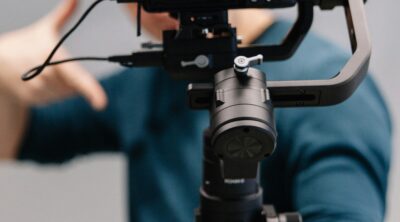< Back to all posts
AI’s Impact on Creativity in Corporate Media
When a technology is as hyped, talked-about and all-encompassing as artificial intelligence is right now, it’s natural to wonder what it means for various facets of business.
In corporate media spaces, there are a few different schools of thought taking shape around generative AI. Is this technology set to boost productivity and reduce busy work? Or is it going to produce conditions that stifle creativity and cause problems for content production teams?
The story of generative AI in creative work is unwritten, and it has the potential to go in either direction. One thing is certain, however: Content creators are currently dealing with unresolved tension between innovation and efficiency, with generative AI at the center of the discussion. Companies’ engagement with the technology has massive implications for the future of creative work.
How has the AI trend affected creative decision-making?
The promise of generative AI, the kind seen in tech demonstrations and trend pieces, is that the technology can shoulder a massive amount of production work. The idea of producing a fully featured video based on a text prompt has fueled the hype behind AI tool releases like OpenAI’s Sora.
While this type of whole-cloth video generation has shown growing pains — for instance, the systems have a hard time maintaining visual continuity — the idea that generative AI is a massive efficiency booster has taken root. This may partially account for some of the moves observed in the corporate video space recently.
Efficiency-minded and budget-conscious companies are making cutbacks in their internal video production departments. With few or no creative professionals on staff, companies have to resort to tech-based solutions or third-party contracts to produce videos and other deliverables.
A general hesitance to invest in creative projects has expanded beyond the corporate space to the larger creative industry. Hollywood productions have been slow to ramp up following the conclusion of recent strikes.
As the months go on and staffing levels stay low, however, both film producers and corporate media creators may find themselves with a distinct problem: Generative AI, for all its capabilities, is not human. This means the key element of high-quality content, storytelling from one person to another fueled by human creativity, is at risk of being lost.
An industry dominated by technology rather than individual storytellers is at risk of suffering both short- and long-term effects. In the near future, brands will likely find it hard to produce innovative and resonant video concepts with stripped-down teams. Further down the line, the problem may become even more acute as a new generation of potential video professionals fails to receive training, mentorship and opportunities for advancement.
What are the advantages and limitations of AI as a creative tool?
With generative AI dominating the creative conversation, it’s important for leaders to understand what it can and can’t do in its present form. Harnessing the real advantages of AI and avoiding its actual pitfalls are essential considerations for any brand building an ambitious creative strategy.
- Advantages of generative AI: Ambitious companies are already embracing AI tool use as an efficiency-building part of the creative workflow. Generative AI algorithms can apply powerful automation to simplify tasks that go into production. These include helpful accessibility functions like transcribing audio and producing subtitles. Editing and visual effects processes can also speed up with an AI assist, allowing creative content producers to accomplish more in less time.
- Limitations of generative AI: The limits of generative AI come from its lack of human creativity. Since algorithms don’t possess general intelligence, they can’t apply context and thus cannot come up with innovative ideas and, if left to their own devices, they may create output that is more uncanny than engaging. There’s another risk factor to think of, as well — the process by which these algorithms learn, scraping data from existing videos, is controversial. Legal challenges and audience backlash are very real dangers when companies entrust their creative processes to generative AI.
Whether AI becomes a valuable creative tool for a particular company can largely come down to what that business decides to do with the technology. Playing to its strengths as a creative enabler is one possible outcome. Suffering from low-quality content due to a mismatch between intention and capabilities is another.
How can companies foster creativity in a world with AI?
Companies are living through a transitional moment for content creation. Dealing with generative AI means engaging with the technology as it is today, while keeping an eye on its future potential.
Teaming up with expert professionals in creative roles, like video content production, is one way to receive vital expert input and make the most of the current landscape, no matter where it goes next. Whether companies still have large internal teams or they’re seeking to bring in a fully formed team, the third-party model remains reliable.
Read our eBook for much more on the challenges facing today’s corporate creators.








Leave a Reply